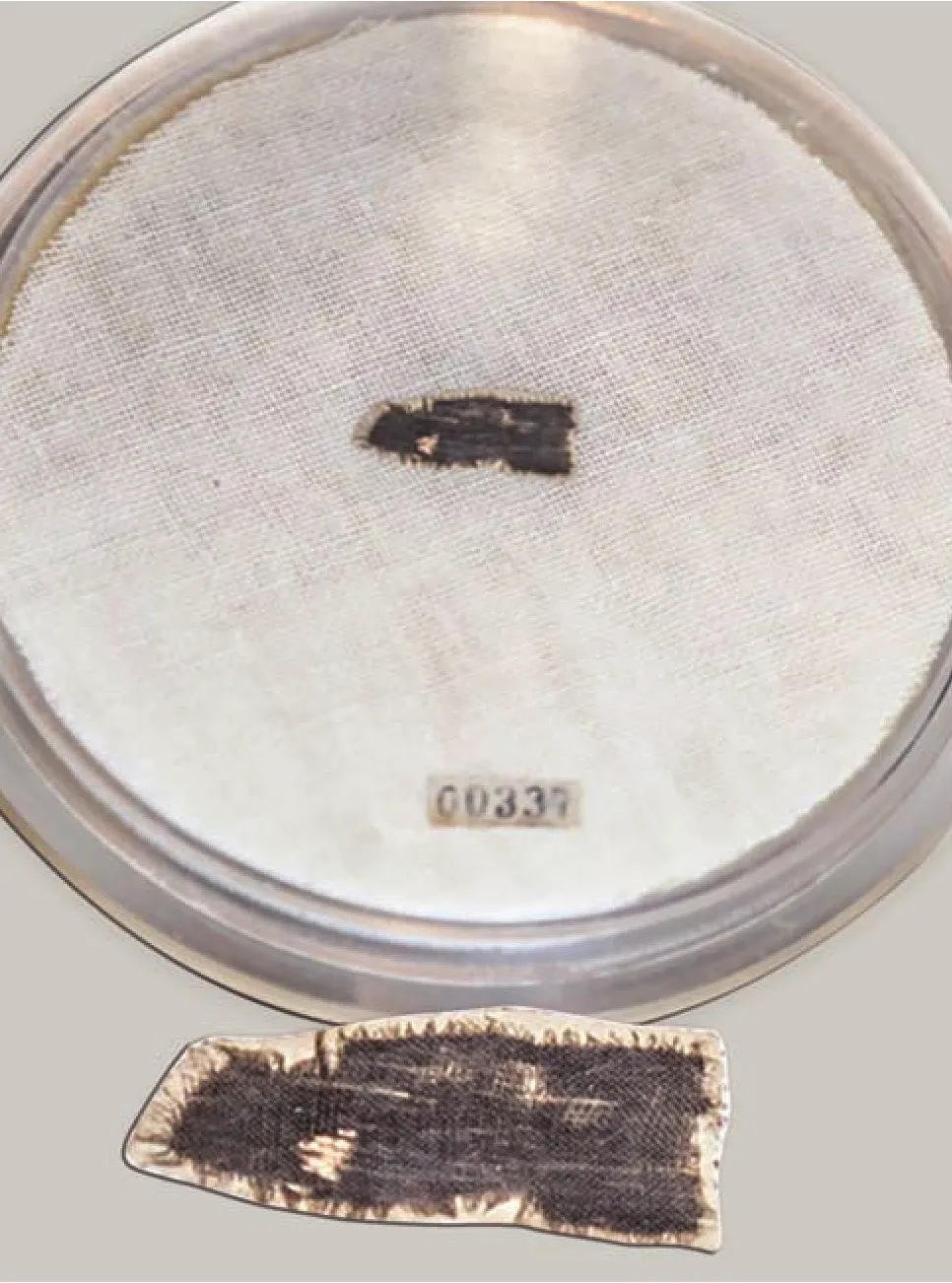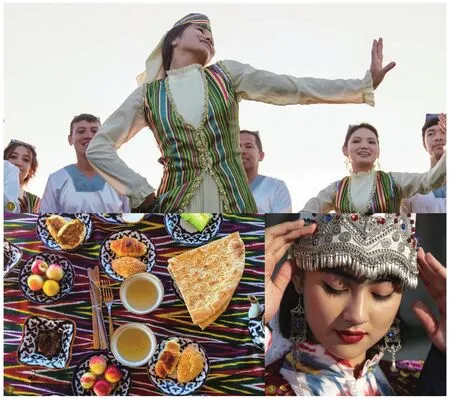丝绸之路:东西方文明之路
文/ 周娅鹃
这是一条驼铃之路,它既是一条有形之路,也是一条无形之路;既是一条经济之路,更是一条文化之路。这条路,走了两千多年,依然绵延不衰—这就是中国连接西域贸易和文化交流的“丝绸之路”。这条路见证了人类文明史上大交流时代的开启,至今仍让整个世界都为之惊艳。
“公元前 114年的中国汉代,张骞带一支从长安出发的和平使团,开始打通东方通往西方的道路,完成了‘凿空之旅’,这就是著名的张骞出使西域。”从西汉到东汉,再到隋、唐、宋、元、明,直到今日,丝绸之路带来经济交往的同时,也带来了中西文化的交融。
如果说两千多年前一条古丝绸之路开东西方文明交流之先河,那么两千多年后的2022年盛夏,丝绸之路沿线国家和地区以及全球文博机构在位于浙江杭州的中国丝绸博物馆举办的第三届“丝绸之路周”活动,则是把建设“丝绸之路经济带”与构建人类命运共同体有机融合起来,旨在推动全球走向共同繁荣。
是什么,让今年的“丝绸之路周”变得不同?
首先,2022年是中国丝绸博物馆建馆三十周年。经过三十年的发展,中国丝绸博物馆已成为收藏和展示丝绸之路沿线丝绸纺织服饰艺术成果的专题博物馆,形成了全链条、研究型、国际化和时尚范四大特色,而其中的国际化之路,正是两千余年丝绸之路的延续。
1993年,时任中国丝绸博物馆副馆长的赵丰第一次出访瑞典讲学,1995年,中国丝绸博物馆的第一个外展赴加拿大蒙特利尔展出,此后约三十年的过程中,中国丝绸博物馆通过丝路之绸、传统工艺、保护修复和当代时尚等板块,在推进丝路之绸研究、纺织品保护科技合作、丝绸时尚展览交流以及参与国际博物馆运行机制建设方面渐渐发挥出重要作用。

1.[唐]玛瑙十二曲长杯。都兰县博物馆藏。 2.[唐]鎏金银王冠(复制品)。乌兰泉沟一号墓出土。3.[唐]骑射形金饰片。都兰县血渭一号墓出土,都兰县博物馆藏。1. Twelve lobbed agate cup (Tang), collected at the Dulan County Museum.2. Gilt silver crown (Tang), replica, excavated from the No. 1 tomb at Quangou cemetery, Wulan county, Qinghai province.3. Gold plaque in the shape of horse riding and arrow shooting, excavated from the No. 1 tomb at Xuewei cemetery and collected at the Dulan County Museum.

“丝绸之路周”开幕式晚会上,《对话画中人》活化复原乌兹别克斯坦撒马尔罕大使厅壁画场景。The performance Dialogue with Figures in the Paintings re-creates the scenes on the murals in the Hall of Ambassadors in Samarkand, Uzbekistan at the opening ceremony of the Silk Road Week.
据《2021年度全国博物馆(展览)海外影响力评估报告》,中国丝绸博物馆在全中国博物馆“海外综合影响力”总榜单上排名第七、“专题类博物馆海外综合影响力”榜单上排名第一、“最受日韩受众关注博物馆”榜单上排名第四、“最受欧美受众关注博物馆”榜单上排名第九。
同时,今年是浙江对口援建青海12周年,又恰逢中华人民共和国和乌兹别克斯坦共和国建交30周年。于是,便有了“民族融合,共同繁荣”这一主题。
聚焦“融合”语境,构建多彩文明、多元文化、多方资源、多维媒介的丝绸之路“新画卷”,依托地方特色文化资源,加强同世界各国合作交流、促进文明对话,是中国丝绸博物馆也是浙江积极举办这届“丝绸之路周”的重要目的。
今年“丝绸之路周”首次开启主宾省、主宾国概念,分别邀请青海省和乌兹别克斯坦共和国作为主宾省和主宾国,深入挖掘青海特有的丝路文化资源,充分展示乌兹别克斯坦共和国丝路特色风情。
特别是今年“丝绸之路周”主会场的丝路年度大展“西海长云:6—8世纪丝绸之路青海道”,备受瞩目。
展览汇集来自青海、甘肃等地丝路沿线文博机构的107件套重点文物,包括30多件珍贵的金银器,特别是一批玛瑙、水晶、琥珀等,是2018年都兰“3·15”大案缴获回来的文物精品。
如此全面系统地将众多文博机构所藏的吐蕃—吐谷浑重磅级藏品集中于一个展览,这在国内尚属首次。
据此次展览的总策展人,中国丝绸博物馆名誉馆长赵丰介绍:“这是第一个关于吐谷浑的历史文化展览,也是第一个丝绸之路青海道的展览,更是第一个聚焦海西吐蕃考古的展览。”除了高规格的展品,展览还采用了大量技术还原手段,还原了风俗画卷、生活场景、墓室结构、考古现场等,向观众展示了6—8世纪吐谷浑人的生活、文化和艺术史,揭示了青海道在沟通东西文化交流中的重大贡献,以及在中华民族多元融合历史过程的重要地位。
作为丝绸之路沿线的重要文化、贸易中心,乌兹别克斯坦承载了几个世纪以来人们迁徙和交流的历史,是共建“一带一路”的重要参与者。
在乌兹别克斯坦东北部地区的历史名城撒马尔罕,有着世界闻名的“拂呼缦宫殿”壁画,也称“大使厅壁画”,反映着公元650年前后唐高宗为粟特(今撒马尔罕)国王拂呼缦(Varkhuman)加封,各方大使来贺的场景。壁画中,既有唐朝使者、粟特国王及侍者,又有吐谷浑使者,与此次活动的主宾省和主宾国的设置神奇呼应,仿佛是壁画人物穿越了千年岁月,跨过了古今时空。
值此契机,中国丝绸博物馆在撒马尔罕国家历史博物馆大使厅上层的展厅里举办了“丝绸与丝路:从杭州到撒马尔罕”特展。展览一方面介绍了来自杭州的UNESCO人类非遗项目“中国蚕桑丝织技艺”,展示了从杭州到撒马尔罕丝绸之路沿途出土的丝绸实物,同时也用复制的中亚织锦,生动还原了大使厅壁画上丝绸之路峰会的盛况,再现了源于中国的丝绸通过古老的丝绸之路走向中亚的美丽故事。该展收到了中国驻乌兹别克斯坦大使馆的书面贺信,将永久落户撒马尔罕。与此同时,在开幕式当晚举办的“SROM 丝绸之路云上策展大赛”颁奖典礼上,《对话画中人》节目将大使厅描绘民族交流与融合的壁画进行了活化复原,表演者们穿着运用现代科技再现的唐朝、吐谷浑及中亚特色服饰,将场内外观众带回公元658年的那次盛会。
两个30周年和一个12周年,既是一种巧合,更像是一种命运的安排,让古丝绸路上的三个文明之地在今天相遇并携手起来,围绕丝绸文明进行了一场深刻而真挚的对话。
是什么,让浙江成功举办“丝绸之路周”?
浙江,与丝绸之路有着深厚渊源 :省会杭州历来享有“丝绸之府”的美誉 ;宁波是记载丝绸之路历史的“活化石”,也是海上丝绸之路的重要节点;浙江多地有着深厚的丝绸文化,比如在湖州,当地的钱山漾遗址出土的迄今4000多年前的丝绸绢片,堪称“世界第一片丝绸”。
然而,“一枝独秀不是春,百花齐放春满园”,浙江连续三年成功举办“丝绸之路周”绝不仅仅凭单打独斗,而是依靠着开放包容、多元互动的“浙江模式”。
在内容策划上,三届“丝绸之路周”分别以“互学互鉴促进未来合作”“多元共存和包容发展”“民族融合,共同繁荣”为主题,注重维护各国各地区文明多样性,致力于促进东西方文化交流和民族多元融合。因此,活动产生了由13个丝路沿线国家的专家学者共同参与和实施的国际合作学术项目“丝绸之路互动地图”,有10个国家20余位专家进行专业推荐和点评的《丝绸之路文化遗产年报》,英、美、俄等16个国家的40余家博物馆共建的“丝绸之路数字博物馆”,由国内外120余所高校和20余座博物馆及广大设计师群体参与的“SROM 丝绸之路云上策展大赛”等丰硕的合作成果。
在参与主体上,自2019年浙江发出“丝绸之路周”活动倡议后,每年都吸引全球多个国家及地区的文化机构与民众线上线下踊跃参与。今年,中国丝绸博物馆还与联合国教科文组织丝绸之路项目合作,在“2022丝绸之路周”的杭州主会场,举办了“大美乌兹:‘UNESCO丝绸之路青年之眼’摄影大赛精选作品展”。此次影展所展出的是“教科文丝绸之路青年之眼”国际摄影大赛精选作品,照片拍摄于乌兹别克斯坦不同的城市,其中包括塔什干、撒马尔罕、布哈拉、希瓦、费尔干纳等,多角度展现了乌兹别克斯坦的建筑遗址、美食、服饰、音乐、舞蹈以及人们的生活风貌。联合国教科文组织官方微信和官网均发布了“2022丝绸之路周”活动预告。

20世纪50年代,浙江湖州钱山漾遗址出土的家蚕丝绢片,堪称“世界第一片丝绸”。这批织物距今已有4200年至4400年,也是世界上迄今发现最早的家蚕丝织品。至此,湖州成为全国乃至世界上最早饲养家蚕和以家蚕蚕丝进行纺织的地区之一。In the 1950s, a piece of silk made from domesticated silkworms unearthed at the Qianshanyang Site in Huzhou, Zhejiang province, was widely regarded as “the world’s first piece of silk”. These fabrics, which date back 4,200 to 4,400 years,are also the earliest silk fabrics made from domesticated silkworms found in the world. Huzhou is recognized as one of China’s and the world’s earliest areas to make textile from domesticated silkworm.
“丝绸之路周”就像浙江精心打造的众多窗口中的一扇,向世界积极展示中华丝绸文化;“丝绸之路周”也像是浙江向世界发出诚挚邀请的一个共享舞台,希望世界各地越来越多不同文化能在这个舞台上展示与交流。
是什么,让丝绸之路经历二千年而不衰?
丝绸之路曾在历史上留下了联结多个文明的、持久的宝贵财富,丝绸之路的线路也几经变迁,但其互通有无、共促发展的使命从未改变,其所体现的人文关怀和普世价值仍能得到广泛认同。
“丝绸之路”一词最早由德国地理学家李希霍芬于1877年在《中国》第一卷中提及,因这条贸易路线上承载的大宗商品—丝绸而得名。
1990年至1995年,联合国教科文组织举行了五次国际性丝绸之路考察,正是由此,丝绸之路真正为全人类共赏。
2014年6月第38届世界遗产大会通过决议,将“丝绸之路 :长安—天山廊道的路网”列入《世界文化遗产名录》。这条廊道由中国、哈萨克斯坦和吉尔吉斯斯坦共同申报,涉及三国共33处丝绸之路遗迹。在廊道的价值评判里有这样一句话:丝绸之路是全世界一个最大的文化公约数。它是这条路上所有国家的贡献。
2013年,中国提出建设“丝绸之路经济带”和“21世纪海上丝绸之路”的合作倡议;2017年5月,中国提出“和平合作、开放包容、互学互鉴、互利共赢”的丝路精神。
现如今,“一带一路”从倡议变为实践,已成为当今范围最广、规模最大的国际合作平台。丝路精神突破了意识形态、社会制度和文化的差异,启发着人们在不断传播、交流、互动中融合发展。这便是中国人满怀诚意地从古代历史发展和文明合作中借鉴而来的创新之举。
丝绸之路绵亘万里、延续千年,曾给人们带来无尽的商贸繁华、文明交汇和文化荟萃。丝绸之路又如同一条来自过去并流向未来的大河,为当今国际社会的文化创造和文明互鉴源源不断地提供启迪,提供共同携手去面对百年未有之大变局的智慧与力量。

1.费尔干纳的乌兹别克舞蹈。Alimkhodjaev Bobur/ 摄©联合国教科文组织丝绸之路项目2.希瓦老城外丰盛的传统乌兹别克早餐。Andrea Van Acker/ 摄©联合国教科文组织丝绸之路项目3.塔什干姑娘。Kamila Yadgarova/ 摄©联合国教科文组织丝绸之路项目1.Uzbek dance at Fergana. Photo by Alimkhodjaev Bobur. Photo credit: UNESCO Silk Roads Program.2. Hearty traditional Uzbek breakfast outside the old city of Khiva. Photo by Andrea Van Acker. Photo credit: UNESCO Silk Roads Program.3. A Tashkent girl. Photo by Kamila Yadgarova. Photo credit: UNESCO Silk Roads Program.
Silk Roads: Passages between Eastern and Western Civilizations
By Zhou Yajuan
The Silk Roads have lasted for more than 2,000 years, and they still continue, connecting China and the Western Regions for trade and cultural exchanges. The routes have witnessed the opening of the era of great exchanges in the history of human civilization, and it has amazed the whole world to this day. “Zhang Qian led a peace mission from Chang’an and started to open up the road from the East to the West in 114 BC.” From then on,the Silk Roads have brought economic exchanges as well as the integration of Chinese and Western cultures. Recently, countries and regions along the Silk Roads, as well as museums around the world held the “Silk Road Week” at the China National Silk Museum in Hangzhou, Zhejiang province. It has organically integrated the construction of the Silk Road Economic Belt with the construction of a community with a shared future for mankind, in a bid to move towards global common prosperity.On July 8, 2022, the “Silk Road Week 2022” kicked off its third edition, though somewhat different from previous years.
First of all, 2022 marks the 30th anniversary of the China National Silk Museum with its collection and display of silk, textile and clothing art along the Silk Roads, and it has formed four characteristics of full chain, academic research, internationalization and fashion. In 1993, Zhao Feng, the then deputy director of the museum, visited Sweden for the first time to give lectures.In 1995, their first outreach exhibition was held in Montreal,Canada. Through the silks along the Silk Roads, traditional crafts,conservation and restoration, and contemporary fashion, the museum has played an important role in promoting research on silks of the Silk Roads, textile protection technology cooperation,silk fashion exhibition and exchange, and participating in the construction of international museum operating mechanisms.
At the same time, this year marks the 12th anniversary of Zhejiang’s pairing up with Qinghai to help the latter’s development, and it also coincides with the 30th anniversary of the establishment of diplomatic relations between the People’s Republic of China and the Republic of Uzbekistan. Thus was born the theme of “Ethnic Integration and Common Prosperity” of this year’s Silk Road Week.
This edition of the “Silk Road Week” initiated the concept of the guest province of honor and the guest country of honor,and invited Qinghai province and the Republic of Uzbekistan respectively, exploring Qinghai’s unique Silk Road cultural resources and displaying Uzbekistan’s Silk Road style, with the exhibitionat the main venue. It brought together 107 sets of cultural relics from museums along the Silk Roads in Qinghai, Gansu and other places, including 30-odd precious gold and silverware, especially a batch of agate, crystal, amber, etc., which were fine relics recovered from a major tomb robbing case in Duran. This was the first time in China that such a comprehensive and systematic collection of the Tibet-Tuyuhun relics was concentrated in one exhibition. In addition to the high-standard exhibits, the organizers also adopted advanced technologies to restore the folklore, life scenes, tomb structures, archaeological sites, etc., revealing Qinghai’s significant contribution to the Eastern and Western cultural exchanges, as well as its important role in the historical process of the integration of the Chinese nation. As an important cultural and trade center along the Silk Roads, Uzbekistan with its history of people’s migration and exchanges for centuries is an important participant in the joint construction of the “Belt and Road”.
In Samarkand in northeastern Uzbekistan, there is a worldfamous mural of the Varkhuman Palace, also known as the Hall of Ambassadors, showing that Emperor Gaozong (628-683)of the Tang dynasty (618-907) anointed the king of Sogdiana(now Samarkand) in around the year 650, and the ambassadors and envoys from around the area came to pay tribute. In the mural, there are envoys from the Tang court, Sogdian kings and attendants, as well as envoys from Tuyuhun, which echoes magically this event, as if the characters in the mural have traveled through thousands of years, across ancient and modern times.
On this occasion, the China National Silk Museum held a special exhibitionin the Hall of Ambassadors in the Samarkand State Museum-Reserve of Uzbekistan. On the one hand, the exhibition introduced the UNESCO intangible cultural heritage project“Chinese sericulture and silk weaving skills” from Hangzhou, and displayed the real silk unearthed along the Silk Roads from Hangzhou to Samarkand. The grand occasion of the Silk Road Summit on the mural in the Hall of Ambassadors was reproduced on Central Asian brocade, in the beautiful story of silk originating in China going to Central Asia through the ancient Silk Roads. The exhibition will be permanently settled in Samarkand. At the same time, at the award ceremony of the “Silk Road Online Museum (SROM) Online Curating Competition” held on the night of the opening ceremony,the performance “Dialogue with People in Paintings” revived and restored the mural in the Hall of Ambassadors.
Focusing on the context of “integration”, building a“new picture” of the Silk Roads with colorful civilizations,multiculturalism, multi-source resources and multi-dimensional media, relying on local characteristic cultural resources,strengthening cooperation and exchanges with countries around the world, and promoting dialogue between civilizations: this is also an important purpose for Zhejiang in energetically holding this edition of “Silk Road Week”.
Zhejiang is intimately connected the Silk Roads: Hangzhou,the provincial capital, has always enjoyed the reputation as a “House of Silk”; Ningbo is a “living fossil” that records the history of the Silk Roads as an important part of the Maritime Silk Road; many other places have a profound silk culture. For example, in Huzhou,the silk piece unearthed from the local Qianshanyang site more than 4,000 years ago is widely regarded as “the world’s first piece of silk”. Zhejiang has successfully held the “Silk Road Week” for three consecutive years thanks to its open, inclusive and plural Zhejiang model.
In terms of contents, the three editions of Silk Road Week have been themed “The Silk Road: Mutual Learning for Future Cooperation”, “Cultural Diversity and Sustainable Development”,and “National Integration and Common Prosperity”, focusing on maintaining the diversity of civilizations in various countries and regions. Therefore, the event produced an international cooperative academic project “Silk Road Interactive Map”, which was jointly implemented by experts and scholars from 13 countries along the Silk Roads. Thewas recommended by a score of expert from ten countries, the Silk Road Online Museum jointly built by more than 40 museums in 16 countries including the United Kingdom,the United States, and Russia, and the SROM Silk Road Online Curating Competition participated by more than 120 universities and 20-odd museums and various international designers. In terms of participants, since Zhejiang launched the “Silk Road Week” initiative in 2019, it has attracted cultural institutions from many countries and regions as well as people to actively participate online and offline every year. This year, the China National Silk Museum cooperated with the UNESCO Silk Road Project in organizing the “Beautiful Uzbekistan: Selected Works Exhibition of the Youth Eyes on the Silk Roads Photo Contest” at the main venue in Hangzhou. The exhibition showcases photos taken in different cities in Uzbekistan,including Tashkent, Samarkand, Bukhara, Khiva, Fergana, featuring Uzbekistan’s architectural ruins, food, clothing, music, dance and people’s life style from multiple angles. The official WeChat account and official website of UNESCO released the announcement of the Silk Road Week 2022, which is like one of many showcases crafted by Zhejiang showing Chinese silk culture to the world. Silk Road Week 2022 is also like a shared stage in Zhejiang serving as a sincere invitation to the world, so that more and more different cultures can be displayed and communicated on this stage.
The Silk Roads have left us a long-lasting treasury connecting multiple civilizations in history. While the routes of the Silk Roads have changed several times, their mission to connect with each other and promote development has never changed. The humanistic and universal values of the Silk Roads are still widely recognized.

“丝绸之路周”主会场的丝路年度大展“西海长云:6—8世纪丝绸之路青海道”展厅。The exhibition hall for Qinghai Path: Silk Road in the 6-8 Centuries, the theme exhibition featured at the 2022 Silk Road Week.

